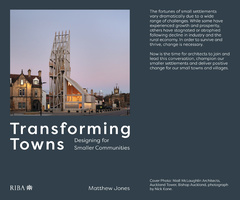Description
Transforming Towns
Designing for Smaller Communities
Author: Jones Matthew
Language: English
Subjects for Transforming Towns:
Keywords
Quantity Surveyor; contemporary architecture; Town Centres; community engagement; Dense; thoughtful urban design; Town Hall; small communities; South Cambridgeshire; low-density housing; Public Engagement; High Quality Public Spaces; Community Asset Transfer; UK's Vote; Bridge Street; Housing Design Awards; Home Towns; Studio Weave; Bishop Auckland; Hebden Bridge; MTI; Covered Market Halls; Ash Sakula; Auckland Castle; St Peter's Square; Outdoor Museum; Small Settlements; Low Density Housing Estates; Performance Workshops; Historic Inn
· 16.6x24 cm · Paperback
Description
/li>Contents
/li>Readership
/li>Biography
/li>
Towns have undergone dramatic and rapid change over the last century. Declining historic cores are surrounded by sprawling low-density housing, industrial and retail estates. The character and sense of place at the heart of rural towns and villages is under threat. By drawing people away from town centres, these developments erode the sense of community and public life.
This book demonstrates how contemporary architecture, community engagement and thoughtful urban design can contribute to the creation of thriving small communities. It addresses a lack of inspiration and ideas for architects and designers working in small communities and promotes a character-based approach to designing and planning 21st century towns.
Foreword by Prof. Wayne Forster, Welsh School of Architecture Introduction 1. Understanding Small Settlements 1.1. What do we mean by towns and smaller communities? 1.2 . History, growth and evolution 1.3. Contemporary challenges facing small communities 1.4. Is now the right time for change? 2. Homes: Creating distinctive places to live 2.1. The need for new homes 2.2. Temple Gardens, Temple Cloud 2.3. Cinque Port Street, Rye 2.4. Project: Tibby’s Triangle, Southwold 2.5. The Avenue, Saffron Walden 2.6. Social Housing, Gistel 2.7. Steepleton Retirement Community, Tetbury 3. Town centres: Building the Heart of a Community 3.1. The changing nature of the town centre 3.2. Warwick Hall Community Centre, Burford 3.3. Marks & Spencer, Northallerton 3.4. School in town, Westport 3.5. Hebden Bridge Town Hall, Hebden Bridge 3.6. Welcome Building, Bishop Auckland 4. Public space: Encouraging social life 4.1. The value of public space 4.2. Bridge Street, Callan 4.3. Prescot Forum, Prescot 4.4. Helensburgh Town Centre, Helensborough 4.5. Clonakilty 400, Clonakilty 5. Long term strategies: Future visions for small settlements 5.1. Recent initiatives to shape future places 5.2. Ruthin Future, Ruthin 5.3. Village Design Guides, South Cambridgeshire 5.4. Sharing Bolsover 5.5. Urban Regeneration Plan, Selb, Germany 6. Conclusion
Dr. Matthew Jones is Associate Professor at the Birmingham School of Architecture and Design, Birmingham City University and a partner at Coombs Jones Architects. He is an architect whose practice, research and teaching have focused on place specific approaches to the development of rural towns. Matthew led the award winning Ruthin Future, a project to develop long term vision for the future of the North Wales town. He has experience in socially engaged and participatory place making, community-led planning, public engagement and university-community live projects. Matthew was a judge for the RIBA President's Awards for Research 2017 and is an Advocate in Practice for Design Commission for Wales.




